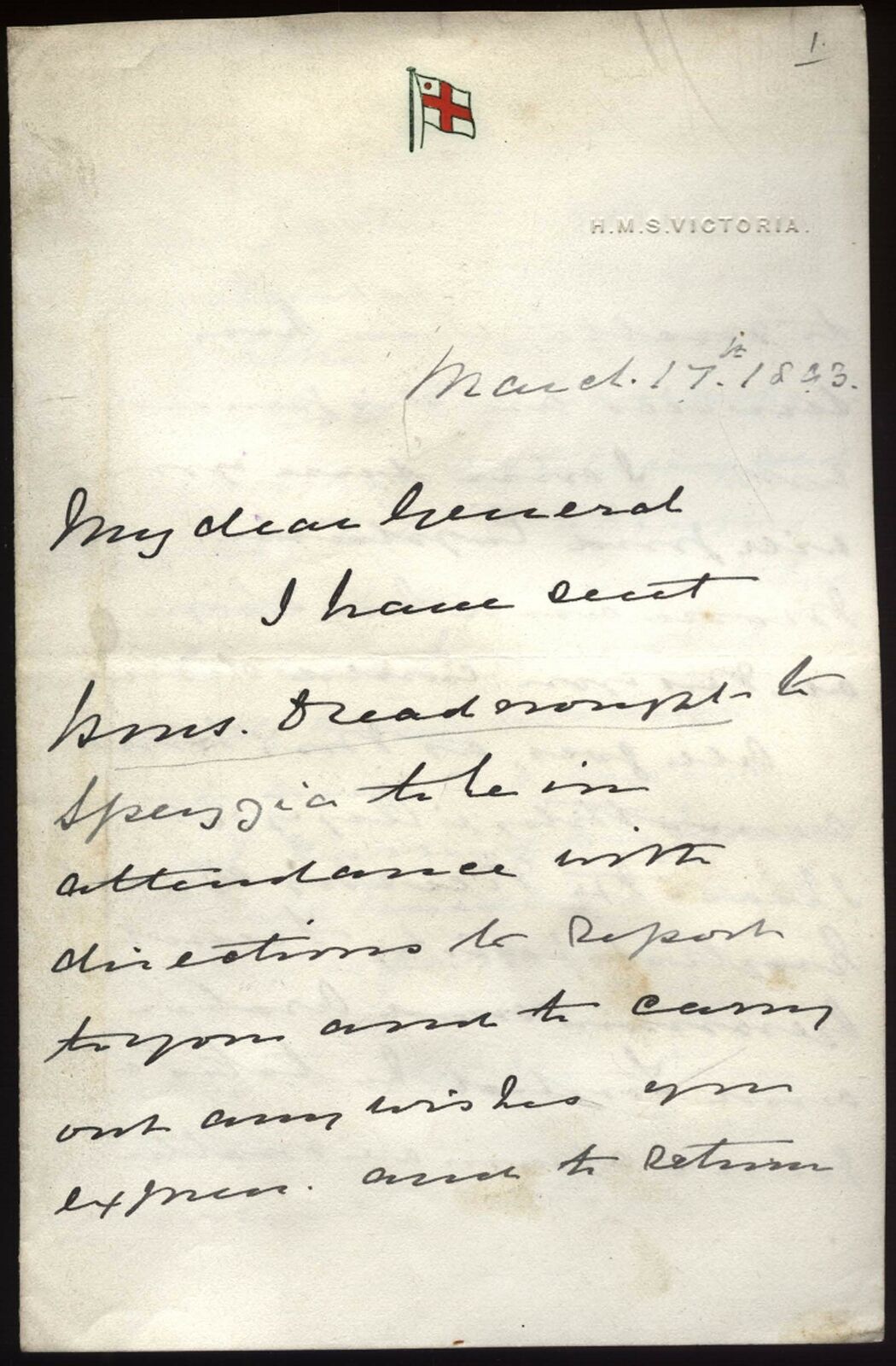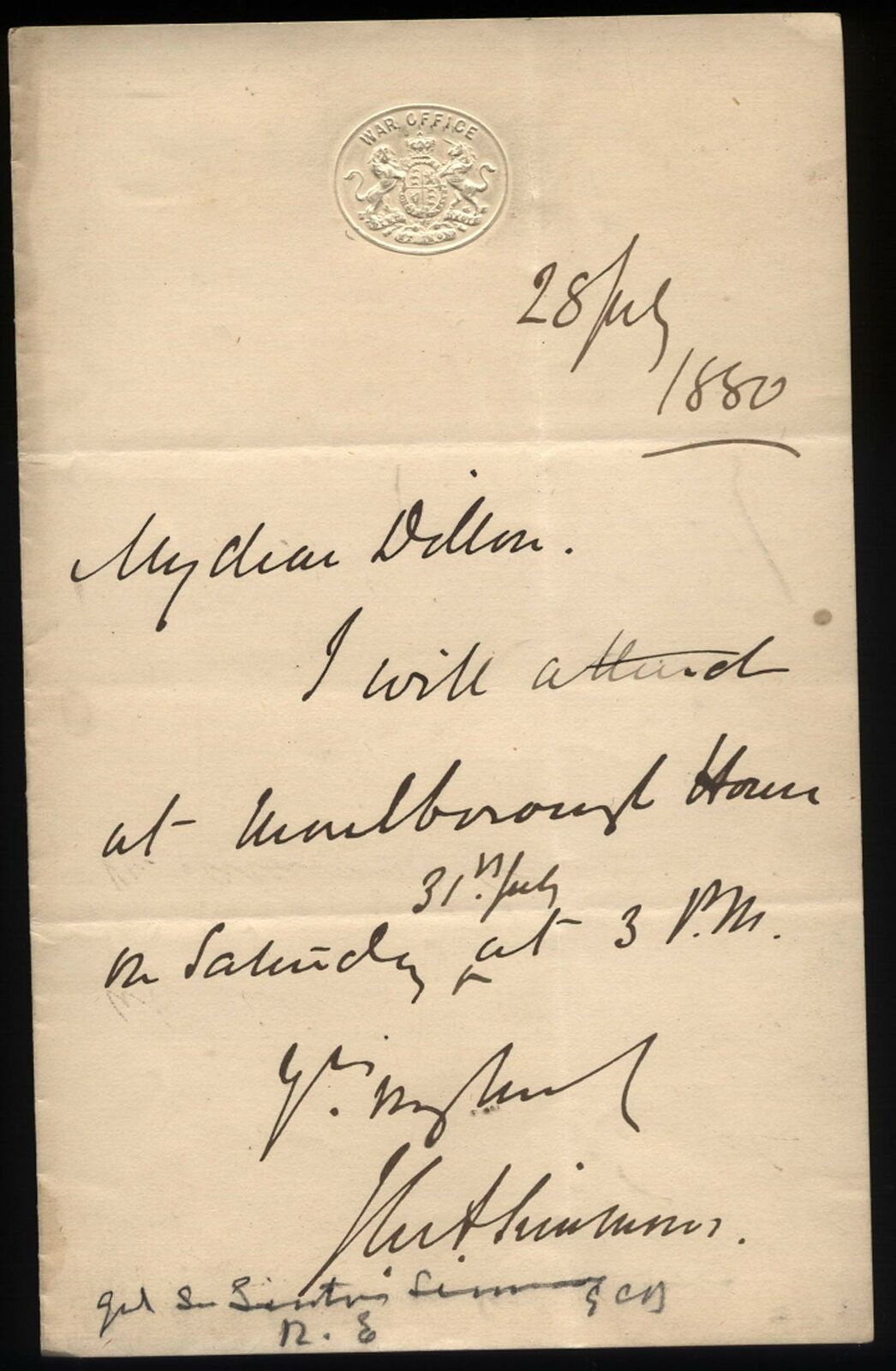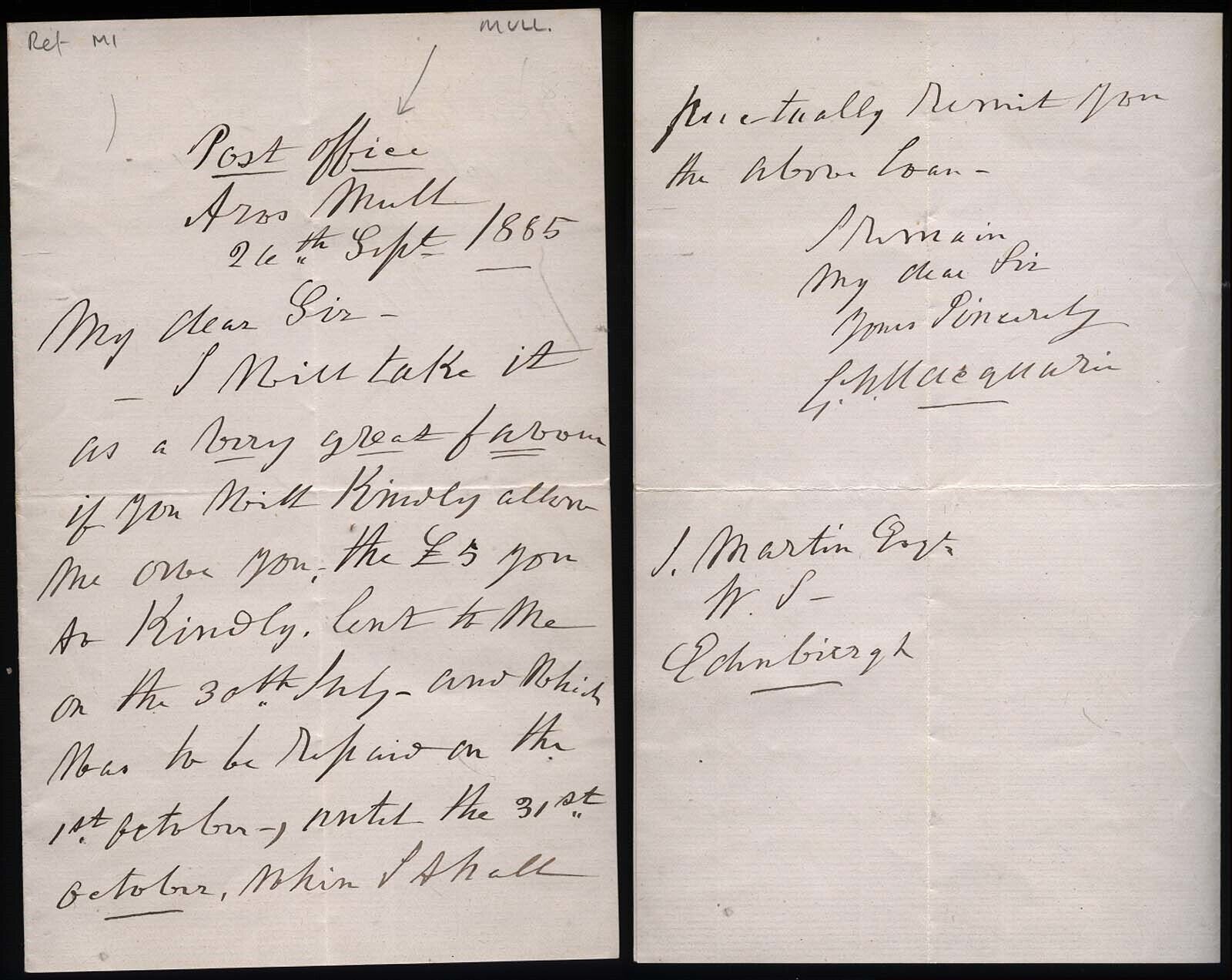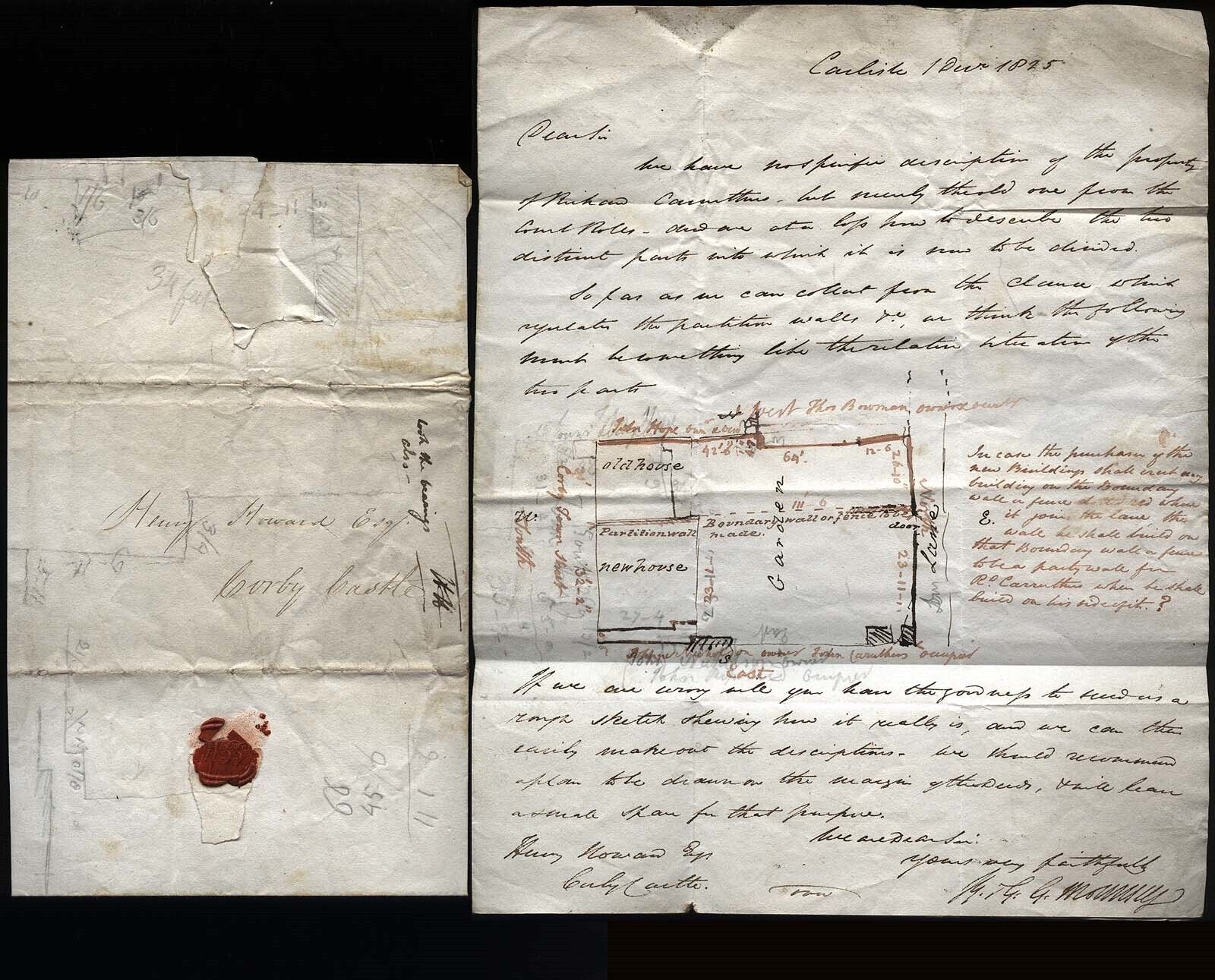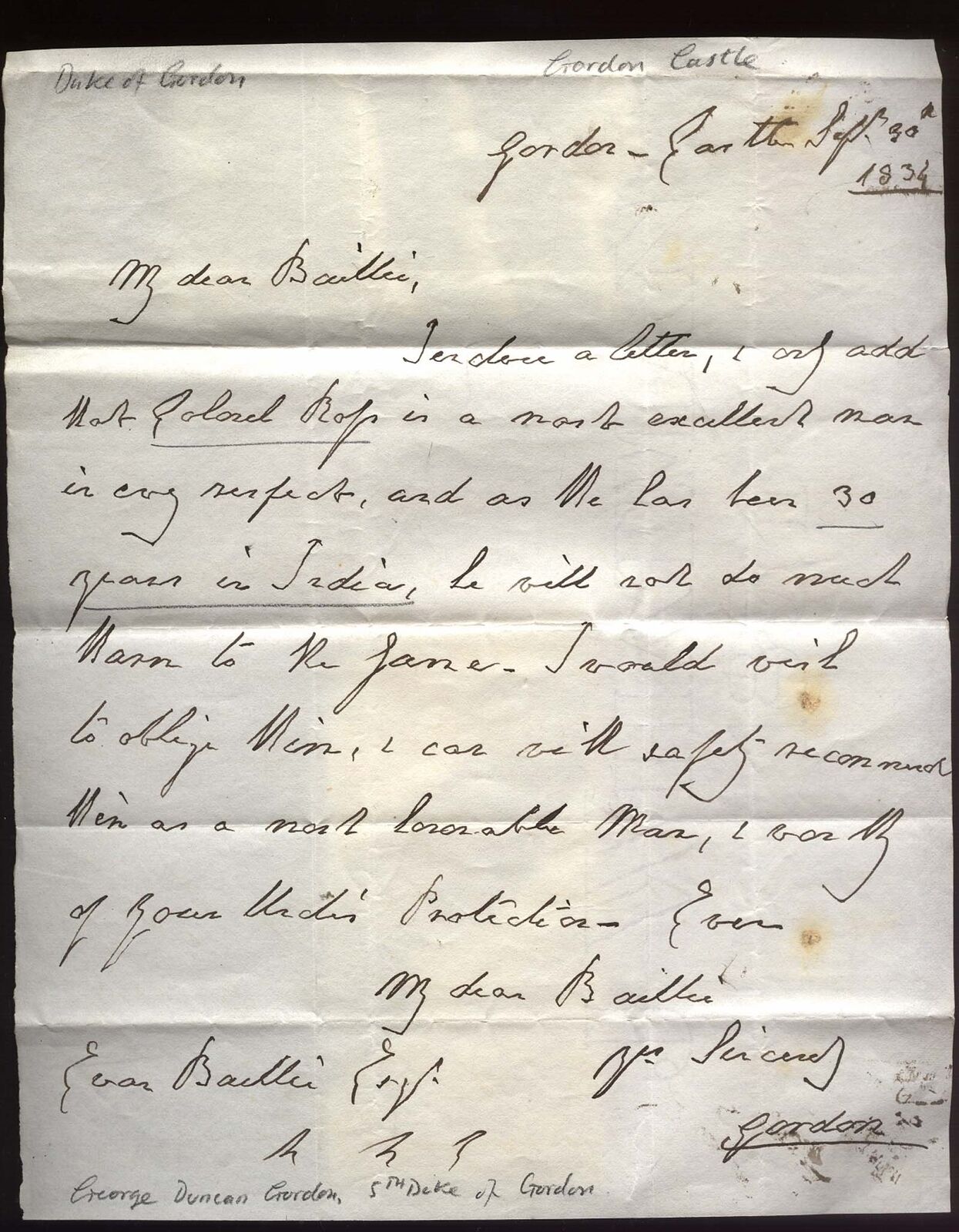-40%
1893 Admiral George Tryon, H.M.S. VICTORIA to Sir Henry Ponsonby, Queen VICTORIA
$ 415.88
- Description
- Size Guide
Description
1893 Admiral George Tryon, H.M.S. VICTORIA to Sir Henry Ponsonby, Queen VICTORIAThis product data sheet is originally written in English.
1893 Important letter, Admiral Sir George Tryon, on board H.M.S. VICTORIA to Sir Henry Ponsonby, Queen Victoria's Private Secretary regarding the arrangements for H.M.S.Dreadnought and her majesty's intended visit to Florence, also the current affairs of the Khedive of Egypt,
( Sir George, only three months later after writing this letter was drowned in a terrible collision when H.M.S. Victoria sank with the loss of 358 men on 22nd June 1893)
the letter reads as follows.
" H.M.S. VICTORIA
March 17th 1893
My Dear General (Ponsonby),
I have sent H.M.S Dreadnought to Spezzia to be in attendance with directions to report to you and to carry out any wishes you express and to return to Malta when her services are dispenced with.
I am sure you will find Captain Moore and his Ship all that you could desire.
All goes at this time smoothly in Egypt. I hear the Viceroy speaks English fairly, French German and Arabic and Turkish, he takes a part in affairs & in matters that his Father did not, for instance the Sirdar General Walker made arrangements not the barracks for the coming artillery and cavalry were to occupy on arrival, all was settled, the Khedive heard of it and made new arrangements and to a certain extent carried his point.
It need hardly be said that when a garrison is small amid a large population the position the troops occupy is an important military consideration. It is not supposed that he is ill disposed to us but he wishes to be felt as Khedive & not to be in leading strings, if he is with us and patience and tact can keep him so & I see no reason why it should not be possible, all should go well, we could hardly expect an active young man to be content to assume precisely the same position as his father was content with.
I am yours very/Sincerely
G.Tryon
I trust you will have fine weather & Her majesty will derive benefit from her visit to Florence."
Vice-Admiral Sir George Tryon KCB (4 January 1832 – 22 June 1893[1]) was a British admiral who died when his flagship HMS Victoria collided with HMS Camperdown during manoeuvres off Tripoli, Lebanon.
Tryon was born at Bulwick Park, Northamptonshire, England, the third son of Thomas Tryon and his wife Anne Trollope. He had three brothers: the eldest, Thomas, joined the 7th Royal Fusiliers, fought at Alma and Inkerman and served through the Indian Mutiny. The second, Henry, passed through Sandhurst before joining the Rifle Brigade, fighting at Alma, Inkerman and Balaclava before being killed in an attack on Russian positions in 1854. George was the third son: the fourth, Richard, also served in the Rifle Brigade. George attended a preparatory school and then Eton College before becoming a naval cadet in 1848, two years older than usual, aged sixteen. The choice of a naval career was made by George himself, rather than his family. Other students reported him to be a quick learner with a wide breadth of knowledge, whether because of his natural ability or his longer period of education before joining the Navy.[2] George was described as 'a tall lanky lad nearly six feet high, full of spirits and fond of a lark'
C-in-C Mediterranean Fleet 1891
In August 1891 Tryon was appointed to command the Mediterranean station, the most powerful force within the Royal Navy at that time. The Mediterranean was recognised as the sea area then of greatest importance to Britain. Tryon left England on 11 September on board HMS Nile meeting the first division of the fleet under its previous commander, vice admiral Sir Anthony Hoskins, on board the flagship HMS Victoria at Gibraltar. Tryon assumed command on 21 September. The division toured Port Mahon, Madelena, Naples, Malta, Nauplia and Milo, where they were joined by the second division under rear-admiral Lord Walter Kerr. The fleet then exercised until November, when they again divided: the first division wintering at Malta while the second remained in the Levant.
Each year the fleet held a regatta where officers and men from different ships competed against each other, training for months in advance. It was customary for the admiral to provide a cup to be presented to the winner of a sailing race between bona fide service boats of all types. In November 1891 the regatta took place at Suda Bay and the winner of 'the admiral's cup' from 60 boats was Lieutenant Evan-Thomas. The race was initially instituted by admiral Phipps Hornby in 1872 with the intention of encouraging skill in sailing, which was becoming a sideline in a steam powered navy.
One of Tryon's first actions as commander was to write a memorandum to all commanders requesting that they draw to his attention anything which might concern the fleet or British interests which they might discover but which in the ordinary way they would not pass on.[76] After the grounding of HMS Howe in 1892 he circulated a memorandum to the fleet concerning safe manoeuvring of ships, particularly in difficult circumstances. Of particular relevance to later events, the memorandum warned commanders that their first duty was always to safeguard their ship (at least, during times of peace) and that should they ever be faced with an order which for some reason might be dangerous, then they should attempt to carry out the intention of the order, but only if it could be done without risk to their ship or others.
As at other stations, the commander of the fleet was provided with a residence and expected to entertain society. The admiral's house in the Strada Mezzodi was one of the smaller auberges, originally palaces for the Knights of St. John. The small size was a disadvantage for the lavish parties which Tryon and his wife were expected to host, but the parties held in the winters of 1891–92 and 1892–93 were very popular. The admiral was the second most important person on the island, after the Governor. The admiral's other duties, aside from running the fleet, included corresponding with the director of Naval Intelligence, Captain Cyprian Bridge, passing on and receiving intelligence reports. This required replying personally to information received from his officers: he was described as a fast writer but with difficult handwriting. The correspondence covered everything from problems the Italian were having with their carrier pigeons to details of international law.
TA, manoeuvres without signals
Admiral Tryon was concerned that the normal system of signalling between ships would become unworkable in real war conditions. To send a signal required hoisting a flag sequence, waiting for all ships to raise flags to confirm they had seen and understood, and then lowering the initial flags to signal everyone to carry it out. The signals book had grown to hundreds of pages describing the many possible flag combinations and virtually no one knew them all. In a real battle this process might take too much time, or might be entirely impossible if enemy fire had destroyed the masts from which the flags must fly, or smoke made them impossible to read. Instead, Tryon proposed a simple signal, using the letter-flags T and A, which simply instructed captains to follow their leader. Other flag signals might be used additionally as circumstances allowed, but once the initial order was given, the ships simply had to follow the movements of their leaders. A few, basic, single flag signals were designated for particular movements, which would simply be flown without needing acknowledgement.[79] This was a radical departure from contemporary practice, in which all movements were precisely signalled from the flagship and acknowledged by their recipients. Opinion was fiercely divided about it, for instance The Times newspaper considered it "unsound in theory and perilous in practice",[citation needed] whilst Rear-Admiral William Kennedy on the East Indies station declared following experiments with it that "the officers commanding thoroughly appreciated the idea which would be invaluable in time of war".
Grounding of HMS Victoria
HMS Victoria (1887)
HMS Victoria, flagship of the Mediterranean fleet, was in retrospect an unlucky ship. In January 1892 she was at Platea in Greece carrying out exercises firing torpedoes, when she ran aground on Snipe Point. Tryon was not on board, as the fleet ships went individually for torpedo practice. This involved firing torpedoes while travelling at speed, but was made more difficult by the need to conduct the practices in shallow waters so the torpedoes could be recovered. Captain Bourke had sent men to mark the point where the waters shallowed to ten fathoms, but they had misjudged the buoy's proper position. Victoria ran aground at nine knots, leaving the fore end of the ship seven feet higher out of the water than normal, while the stern still had 66 feet of water beneath it. The ship was secured with anchors and unsuccessful attempts were made by the nearby torpedo-depot ship to tow her free. Tryon arrived from Malta on board the Surprise, having given orders for the dockyard tug Sampson, Phaeton, Edinburgh, Dreadnought, Scout and Humber to come to assist. Victoria was refloated six days after grounding, towed by Dreadnought and Edinburgh, with the tug lashed to her side and her own engines running astern. 1200 tons had been removed from the ship to lighten her. Victoria returned to Malta for repairs to torn plates along her bottom.
Victoria was repaired in time for the fleet summer cruise in May. The first division sailed from Malta on 31 May for Nauplia, where they were joined by the second division commanded by rear-admiral Markham. The entire fleet then exercised in the Aegean Sea. In June Tryon visited the Sultan of Turkey in Constantinople. Warships were not permitted in the Dardanelles, so the party went on the admiral's steam yacht, Surprise. Captains Bourke from Victoria, Noel from Nile and Wilson from Sans Pareil accompanied Tryon, who received the Medjidie of the first class from the Sultan. They rejoined the fleet at Vourlah Bay on 25 June. In July the fleet divided, with the second division going to the Levant while Tryon and the first division went to Sicily, where the volcano Mount Etna was erupting. The tour continued around Italian and Spanish ports with a fortnight at Gibraltar, before returning to Malta on 29 September. On 10 October once again they set out to Nauplia to meet the second division.
The annual regatta pulling races were held at Salonica, and the sailing races at Lemnos. An additional prize was presented by the Vali of Salonica to the winners of the all-comers race. Tryon directed that the junior midshipman should accept the prize for the winners, on the grounds that he would most likely live longest to remember the event. The sailing events took place at Moudros Bay, a large expanse of water largely surrounded by low-lying land providing good sailing conditions, and plenty of opportunity for officers to go ashore and hunt local game. On this occasion the admiral's cup was won by Commander Tate of the Colossus. The two divisions now separated again, the first with Tryon returning to Malta for the winter.
Sinking of HMS Victoria and drowning of Vice-Admiral Tryon
On 22 June 1893, the fleet was on exercises when Tryon's flagship, HMS Victoria, sank[83] following a bizarre order from him which brought it in collision with the flagship of his second-in-command, Rear Admiral Sir Albert Markham. Tryon went down with his ship, his last reported words being "It is all my fault". Tryon was considered by many of his contemporaries to be a supremely competent yet radical officer,[84] but with a strong and sometimes overbearing personality. This manner was felt to be a contributory cause to the accident. For instance, an article in Society Journal Talk in July 1893 (following the accident) said, "Much has been said about George Tryon's charm of manner, and the rest of it, but in truth he was, at any rate when officially engaged, a very brusque and dictatorial man. Unfortunately he was a 'viewy' man too, a man of theories..."
Major-General Sir Henry Frederick Ponsonby GCB PC (10 December 1825 – 21 November 1895), was a British soldier and royal court official who served as Queen Victoria's Private Secretary
Born in Corfu, he was the son of Major-General Sir Frederick Cavendish Ponsonby, an Anglo-Irish nobleman who was a senior commander in the British Army.
He entered the army on 27 December 1842 as an ensign in the 49th Regiment of Foot. Transferred to the Grenadier Guards, he became a lieutenant on 16 February 1844, captain on 18 July 1848, and major on 19 October 1849. From 1847 to 1858 he was aide-de-camp to Lord Clarendon and Lord St. Germans, successively lord-lieutenants of Ireland. He served through the Crimean campaigns of 1855–56, becoming lieutenant-colonel on 31 Aug. 1855; for the action before Sebastopol he received a medal with clasp, the Turkish medal, and the Order of the Medjidie, 3rd Class.
After the peace he was appointed equerry to Albert, Prince Consort, who greatly valued his services. On 2 August 1860 he became colonel, and in 1862, after the death of the prince, he was sent to Canada in command of a battalion of the Grenadier Guards which was stationed in the colony during the American Civil War. On 6 March 1868 he became a major-general.
Ponsonby embellished letters to his children at Eton with a series of illustrations in which he concealed the school's address. It was a family quirk continued by his son, Arthur Ponsonby, and recently revived by descendant Harriet Russell. His letters bore addresses appearing as doodled signposts in snowstorms or as huge envelopes shouldered by tiny people.
He served as Keeper of the Privy Purse and Private Secretary to Queen Victoria. His appointment occurred on 8 April 1870, after the death of prior Private Secretary General Sir Charles Grey, who was "a son of Earl Grey, the Prime Minister" at the time and who was wife Mary Ponsonby's "Uncle Charles." Both Arthur and Mary Ponsonby contributed pseudonymously to magazines and newspapers of the day.
On 6 January 1895 he was attacked by paralysis; in May he retired from his offices, and on 21 November he died at East Cowes on the Isle of Wight. He was buried at Whippingham.
On 30 April 1861, he married Hon. Mary Elizabeth Bulteel, Maid of Honour to Queen Victoria and a daughter of John Crocker Bulteel (1793–1843) MP. The couple had five children:
Alberta Victoria Ponsonby (6 May 1862 – 15 October 1945)
Magdalen Ponsonby (24 June 1864 – 1 July 1934)
John Ponsonby (25 March 1866 – 26 March 1952)
Frederick Edward Grey Ponsonby (16 September 1867 – 20 October 1935)
Arthur Augustus William Harry Ponsonby (16 February 1871 – 24 March 1946)
Lady Caroline Lamb (née Ponsonby), his father's sister, had been married to Lord Melbourne, a crucial advisor to Queen Victoria during her first years on the throne
Fresh to the Market Place, from Major-General Sir John Ponsonby's Collection
For more from this collection see our shop category for SIR JOHN PONSONBY COLLECTION
John Ponsonby (British Army officer)From Wikipedia, the free encyclopedia
Major-General Sir John Ponsonby KCB CMG DSO (25 March 1866 – 26 March 1952) was a British Army officer who commanded 5th Division during World War I
Born the son of Sir Henry Ponsonby (Queen Victoria's Private Secretary), his Mother Hon. Mary Elizabeth Ponsonby, Maid of Honour to Queen Victoria and a daughter of John Crocker Bulteel.
His brothers were Frederick Ponsonby, ( Assistant Private Secretary to Edward VII & GV), and Arthur Augustus William Harry Ponsonby, 1st Baron Ponsonby of Shulbrede, (British politician, writer, and social activist).
Sir John was educated at Eton College, He was gazetted to the Royal Irish Rifles 16 November 1887, and to the Coldstream Guards 15 August 1888, becoming Lieutenant 29 June 1891. He was ADC to the Governor and Commander-in-Chief, South Africa, 10 August 1891 to 30 January 1895; served in operations in Matabeleland (Medal); was promoted to Captain 7 September 1898, and in that year served in Uganda (Medal), and again in 1899, during the operations against Kabarega (clasp). Captain Ponsonby served in the South African War, 1899-1902, on special service with the Rhodesian Field Force, 19 February 1900 to 7 July 1901. He was Adjutant, 5th New Zealand Regiment, 8 June 1900 to 1 January 1901; afterwards in command 1 January to 18 January 1901. From February to May 1900, be was employed with Mounted Infantry, and he took part in operations in the Transvaal, west of Pretoria, from July to 29 November 1900; operations in the Transvaal, February to June 1901; operations in Cape Colony, February to 31 May 1902. He was mentioned in Despatches [London Gazette, 10 September 1901]; received the Queen's Medal with four clasps, the King's Medal with two clasps, and was created a Companion of the Distinguished Service Order [London Gazette, 27 September 1901]: "John Ponsonby, Captain, Coldstream Guards. In recognition of services during the operations in South Africa". The Insignia were presented by the King 27 October 1901. He was promoted to Major 23 January 1904, and commanded the Guards' Depot 1 March 1905 to 28 February 1907. He became Lieutenant Colonel 28 October 1913. Lieutenant Colonel Ponsonby served in the European War, 1914—18; commanded the 2nd Guards Brigade, BEF, 26 August 1915 to 19 November 1916: was given the Brevet of Colonel 1 January 1916; commanded the Special Reserve Infantry Brigade 28 November 1916 to 7 March 1917; commanded the 21st Infantry Brigade, BEF, 8 March to 20 March 1917; became Colonel 20 March 1917; commanded the 2nd Guards Brigade, British Armies in France, 21 March to 21 August 1917; commanded the 40th Division, British Armies in France, 22 August 1917 to 3 July 1918; subsequently commanded the 5th Division, British Armies in France, 4 July 1918 to 1 April 1919; was promoted to Major General 1 January 1919. He was mentioned in Despatches; created a CMG in 1915, a CB in 1918, and was given the Brevet of Colonel.
He went on to become General Officer Commanding 5th Division remaining in that role until the end of the War. After the War he became General Officer Commanding the Madras District of India. He retired in 1928.
He lived at Haile Hall near Beckermet in Cumbria
:
Powered by SixBit's eCommerce Solution
1893 Important letter, Admiral Sir George Tryon, on board H.M.S. VICTORIA to Sir Henry Ponsonby, Queen Victoria's Private Secretary regarding the arrangements for H.M.S.Dreadnought and her majesty's intended visit to Florence, also the current affairs of the Khedive of Egypt, ( Sir George, only three months later after writing this letter was drowned in a terrible collision when H.M.S. Victoria sank with the loss of 358 men on 22nd June 1893) the letter reads as follows. " H.M.S. VICTORIA March 17th 1893 My Dear General (Ponsonby), I have sent H.M.S Dreadnought to Spezzia to be in attendance with directions to report to you and to carry out any wishes you express and to return to Malta when her services are dispenced with. I am sure you will find Captain Moore and his Ship all that you co
Type
Historical
Related Interests
Sir Henry Ponsonby
EAN
Does Not apply
Country
England
Related Interests 2
H.M.S. VICTORIA
Autograph Type
Manuscript Letter
Era
1891-1900
Middle Eastern Countries
Egypt
Theme 2
Queen Victoria
Document Type
Manuscript Letter
Continent
Middle East
Year of Issue
1893
Titled Families
Admiral Sir George Tryon
